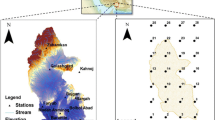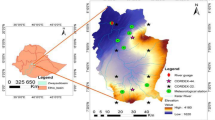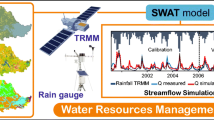Abstract
In recent years, global reanalysis weather data has been widely used in hydrological modeling around the world, but the results of simulations vary greatly. To consider the applicability of Climate Forecast System Reanalysis (CFSR) data in the hydrologic simulation of watersheds, the Bahe River Basin was used as a case study. Two types of weather data (conventional weather data and CFSR weather data) were considered to establish a Soil and Water Assessment Tool (SWAT) model, which was used to simulate runoff from 2001 to 2012 in the basin at annual and monthly scales. The effect of both datasets on the simulation was assessed using regression analysis, Nash-Sutcliffe Efficiency (NSE), and Percent Bias (PBIAS). A CFSR weather data correction method was proposed. The main results were as follows. (1) The CFSR climate data was applicable for hydrologic simulation in the Bahe River Basin (R 2 of the simulated results above 0.50, NSE above 0.33, and |PBIAS| below 14.8. Although the quality of the CFSR weather data is not perfect, it achieved a satisfactory hydrological simulation after rainfall data correction. (2) The simulated streamflow using the CFSR data was higher than the observed streamflow, which was likely because the estimation of daily rainfall data by CFSR weather data resulted in more rainy days and stronger rainfall intensity than was actually observed. Therefore, the data simulated a higher base flow and flood peak discharge in terms of the water balance, except for some individual years. (3) The relation between the CFSR rainfall data (x) and the observed rainfall data (y) could be represented by a power exponent equation: y=1.4789x 0.8875 (R 2=0.98, P<0.001). There was a slight variation between the fitted equations for each station. The equation provides a theoretical basis for the correction of CFSR rainfall data.
Similar content being viewed by others
References
Abbaspour K C, Rouholahnejad E, Vaghefi S et al., 2015. A continental-scale hydrology and water quality model for Europe: Calibration and uncertainty of a high-resolution large-scale SWAT model. Journal of Hydrology, 524: 733–752.
Barrett C B, 1993. The development of the Nile hydrometeorological forecast system. Journal of the American Water Resources Association, 29: 933–938.
Blacutt L A, Herdies D L, Gonçalves L G G D et al., 2015. Precipitation comparison for the CFSR, MERRA, TRMM3B42 and Combined Scheme datasets in Bolivia. Atmospheric Research, 163: 117–131.
Dile Y T, Srinivasan R, 2014. Evaluation of CFSR climate data for hydrologic prediction in data-scarce watersheds: An application in the Blue Nile River Basin. Journal of the American Water Resources Association, 50(5): 1226–1241.
Fuka D R, Walter M T, MacAlister C et al., 2014. Using the Climate Forecast System Reanalysis as weather input data for watershed models. Hydrological Processes, 28(22): 5613–5623.
Gupta H V, Sorooshian S, Yapo P O, 1999. Status of automatic calibration for hydrologic models: Comparison with multilevel expert calibration. Journal of Hydrologic Engineering, 4(2): 135–143.
Hu S, 2015. Simulation and prediction research of the ecohydrological process based on SWAT model in Beiluo River Basin [D]. Xi’an: Northwest University. (in Chinese)
Hu Y Z, Ni Y Y, Shao H et al., 2013. Applicability study of CFSR, ERA-Interim and MERRA precipitation estimates in Central Asia. Arid Land Geography, 36(4): 700–708. (in Chinese)
Lai Z Q, Li S, Li C G et al., 2013. Improvement and applications of SWAT model in the upper-middle Heihe River Basin. Journal of Natural Resources, 28(8): 1404–1413. (in Chinese)
Liu C M, Xia J, Guo S L et al., 2004. Advances in distributed hydrological modeling in the Yellow River basin. Advances in Water Science, 15(4): 495–500. (in Chinese)
Liu G H, Luan Z Q, Yan B X et al., 2014. Runoff simulation for marsh rivers in Sanjiang Plain based on SWAT model. Journal of China Hydrology, 34(1): 46–51. (in Chinese)
Moriasi D N, Arnold J G, Liew M W V et al., 2007. Model evaluation guidelines for systematic quantification of accuracy in watershed simulations. Transactions of the ASABE, 50(3): 885–900.
Nash J E, Sutcliffe J V, 1970. River flow forecasting through conceptual models (Part 1): A discussion of principles. Journal of Hydrology, 10(3): 282–290.
Rouholahnejad E, Abbaspour K C, Srinivasan R et al., 2014. Water resources of the Black Sea Basin at high spatial and temporal resolution. Water Resources Research, 50(7): 5866–5885.
Sharp E, Dodds P, Barrett M et al., 2015. Evaluating the accuracy of CFSR reanalysis hourly wind speed forecasts for the UK, using in situ measurements and geographical information. Renewable Energy, 77: 527–538.
Tang W, Lin Z H, Yang C G et al., 2014. Evaluation of a hydrological simulation over the Huaihe River basin using the coupled land surface and hydrologic model system and its uncertainty analysis. Climatic and Environmental Research, 19(4): 463–476. (in Chinese)
Troin M, Caya D, Velázquez J A et al., 2015. Hydrological response to dynamical downscaling of climate model outputs: A case study for western and eastern snowmelt-dominated Canada catchments. Journal of Hydrology Regional Studies, 4: 595–610.
Wang L, Chen X W, 2008. Simulation of hydrological effects on vegetation restoration of degraded mountain ecosystem with SWAT model. Journal of Mountain Science, 26(1): 71–75. (in Chinese)
Wang Z G, Liu C M, Huang Y B, 2003. The theory of SWAT model and its application in Heihe Basin. Progress in Geography, 22(1): 79–86. (in Chinese)
Ward E, Buytaert W, Peaver L et al., 2011. Evaluation of precipitation products over complex mountainous terrain: A water resources perspective. Advances in Water Resources, 34(10): 1222–1231.
Worqlul A W, Maathuis B, Adem A A et al., 2014. Comparison of rainfall estimations by TRMM 3B42, MPEG and CFSR with ground-observed data for the Lake Tana basin in Ethiopia. Hydrology & Earth System Sciences, 18(18): 4871–4881.
Xiang H, Zhang F, Jiang J et al., 2014. Analysis of global cloud amount over the past 30 years based on CFSR data. Meteorological Monthly, 40(5): 555–561. (in Chinese)
Xu S Q, Chen J, Song R G, 2010. The application study of NCEP reanalysis data. Journal of Qingdao University (Natural Science Edition), 23(3): 38–41. (in Chinese)
Ye B S, Yang D Q, Ding Y J et al., 2007. A bias-corrected precipitation climatology for China. Acta Geographica Sinica, 62(1): 3–13. (in Chinese)
Yu Y M, Mu Z X, 2015. Applicability of CFSR data in runoff simulation of cold highland area. Journal of Irrigation and Drainage, 34(11): 93–97. (in Chinese)
Zhao H G, Yang S T, Wang Z W et al., 2015. Evaluating the suitability of TRMM satellite rainfall data for hydrological simulation using a distributed hydrological model in the Weihe River catchment in China. Journal of Geographical Sciences, 25(2): 177–195.
Zhao T B, Fu C B, Ke Z J et al., 2010. Global atmosphere reanalysis datasets: Current status and recent advances. Advances in Earth Science, 25(3): 242–254. (in Chinese)
Zhou Z B, Wang H, Jia Y W et al., 2005. Temporal downscaling daily precipitation in lack-data watershed: A case study in Yellow River. Resources Science, 27(1): 92–96. (in Chinese)
Author information
Authors and Affiliations
Corresponding author
Additional information
Foundation: International Partnership Program of Chinese Academy of Sciences, No.131551KYSB20160002; National Natural Science Foundation of China, No.41401602; Natural Science Basic Research Plan in Shaanxi Province of China, No.2014JQ2-4021; Key Scientific and Technological Innovation Team Plan of Shaanxi Province, No.2014KCT-27; Graduate Student Innovation Project of Northwest University, No.YZZ15011
Hu Sheng (1988–), PhD Candidate, specialized in hydrology, water resources, and geological disasters.
Qiu Haijun, Associate Professor, specialized in geological disasters.
Rights and permissions
About this article
Cite this article
Hu, S., Qiu, H., Yang, D. et al. Evaluation of the applicability of climate forecast system reanalysis weather data for hydrologic simulation: A case study in the Bahe River Basin of the Qinling Mountains, China. J. Geogr. Sci. 27, 546–564 (2017). https://doi.org/10.1007/s11442-017-1392-6
Received:
Accepted:
Published:
Issue Date:
DOI: https://doi.org/10.1007/s11442-017-1392-6




